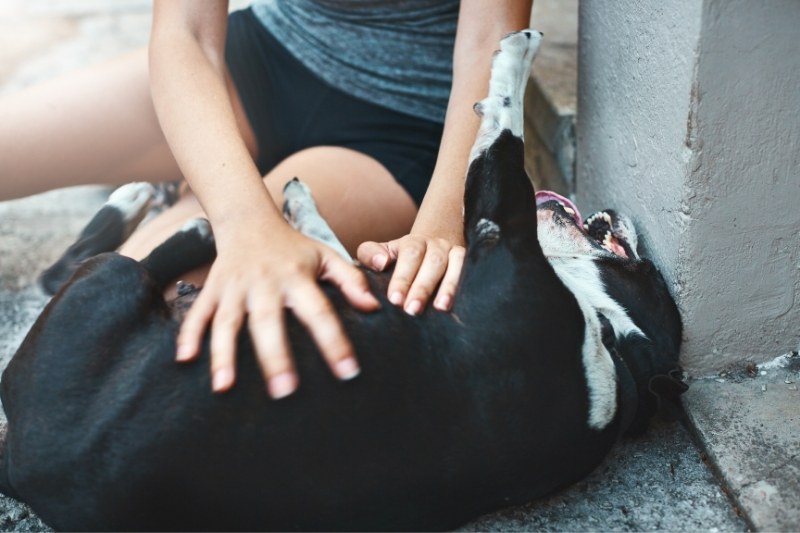Do dogs talk to each other?

How amazing would it be if your pup not only ran up to other dogs at the doggie park but could also have a conversation with them? Telling them all about the walk you took them on that morning, the new fresh food you're trying out, or the seriously comfy bed you've just bought them?
They may not ‘talk' in the sense that we completely understand, but dogs definitely communicate with each other. Not only does it help them to know their place in a friendship group or family but it can also be really useful for us owners too.
So, how do dogs talk to each other?
What's the history of dogs communicating?
Dogs are sociable creatures that have always been part of a pack – whether that's roaming the vast and difficult terrain as wolves or being part of your family. Because they're so sociable they needed to develop a language in order to communicate with one another, protect their territory and successfully hunt.
Of course, when dogs communicate they don't speak like we do, but they do have a language that's mostly made up of body language and other signals.
How do dogs communicate with each other?

There are many ways in which our furry friends learn to communicate with other dogs (and sometimes people).
Via smell
Dogs have something called a Jacobson’s or ‘Vomeronasal’ organ which is located just within their nasal cavity. This organ is connected straight to the brain via nerves and allows your pup to smell all sorts of odors – some of which are even odorless. Just like magic.
One of the main reasons a dog sniffs around another dog's face and butt is because they smell different types of hormones and can actually get a lot of information about the dog based on them. They can tell if they're available for breeding and identify them based on their smell!
Barking
There are many reasons why a dog barks. They may be scared, happy, alerting you to something, or showing signs of aggression. How your dog barks and in what pitch can tell you (and other dogs) a lot about how they're feeling.
For example, dogs barking in a low, growly pitch indicates that they're scared, angry, or likely to be aggressive. A high pitch ‘jolly' sounding bark normally tells you that they're excited. Imagine that moment when you take your pup to the dog park and they see their friends, the short burst of barking they do is them saying that they're happy to see the other dogs.
It's not just about barking. Dog communication can be all kinds of noises. When a dog yips or makes a high-pitched sound it could be in pain (this quite often happens in a particularly boisterous game of tag in the dog park). Of course, you should check to see that your pup is OK, but they may just be letting the other players know that that was a little rough for them.
Facial expression
It's not all about barking dogs and the sounds they make. Just like with us humans, body language is crucial for a doggie conversation. If their eyes are bright, their mouth open (like a dog smile), and their ears forward then you have a relaxed and happy pup. A dog's ears can tell you a lot about how they're feeling. If their ears are to the side, they're tightening their jaw, and their eyes are looking from side to side, they're probably anxious and feeling really uncertain.
If their ears are upright, they're showing their teeth, snarling, and all whilst giving the other dog a good hard snare, they may be trying to intimidate them or even show signs of aggression. It's important to look at their head position and what their mouths, ears, and eyes are saying.
Specific movements
The position of your pup's head is really important when it comes to dog language. If your dog bows when they meet another dog, they may be initiating a game of tag or other forms of play. It may also be their way of apologizing to another pup.
It's almost a little bit human, but when a dog gives another dog a paw slap it's their way of greeting them and letting them know that they're happy to see them. They're communicating a happy hello!
Biting is another way that dogs ‘talk' and it isn't always as violent as it sounds. When dogs meet and they want to play with each other they may bite or nip in a friendly way – almost like they're biting the air around their playdate. Their body language is very relaxed and joyful and it's quite obvious that it's not aggressive. Your pup's body signals will be very different if they really feel threatened or aggressive.
Position of their head
Hierarchy is really important in packs and pups have a few different ways of showing their fellow canines that they're submissive or dominant. If your dog has their head resting on the back of another pup, this is a clear sign of their dominance. It's not an aggressive act but rather a show for the other dogs.
If your dog is hanging their head or you can see that it's lowered, this could be a sign of sadness or of submission to another dog around them.
Why is it important to see the signs?

If you can understand what your pup is trying to communicate, you can also pick up on cues and react quickly. If your dog is showing signs of anxiety or aggression, you can swiftly remove them from the situation. Likewise, if their body language and facial expressions are very positive, you know they're enjoying the game and you should do it more often!
So, do dogs communicate with each other? Yes! Whilst they may not be able to tell their friend exactly where they went on that walk, what their new food is, or where you got the bed from, they certainly can communicate with each other. They can express emotions through body language and how they position themselves – as well as using smell and barking too!
Can you understand what your dog is trying to say? How do they communicate with you?
I’m Charlotte, a content and copywriter from the North of England and currently living in Berlin. Animals have always been a huge part of my life, so writing about dogs is a total pleasure! I love all kinds of dogs and their cheeky personalities, but I’d have to say Weimaraners are my favourite!








